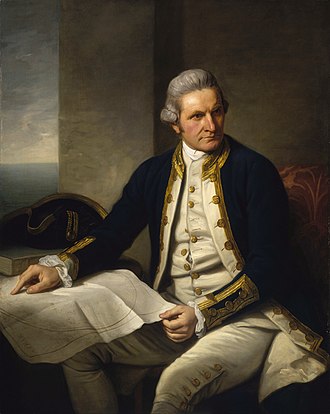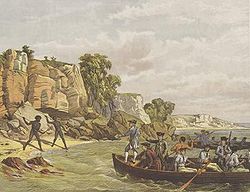James Cook
Captain James Cook, FRS (27 October 1728 – 14 February 1779)[1] was a British explorer, navigator and cartographer. He sailed through the Pacific Ocean three times, mapped many areas and recorded several islands and coastlines on European maps for the first time. He was the first British sailor to visit both the east coast of Australia and the Hawaiian Islands. He made the first European maps of Newfoundland and New Zealand.
He sailed twice around the world. He crossed the Antarctic Circle and visited islands and landscapes in North America and the South Pacific. During his trips, he spent a lot of time on science experiments and improving maps. He also wrote many books about what he found.
Life
Cook was born on 27 November 1728 in Marton, Yorkshire, England.[1] He was a son of a Scottish farmer. He was educated at the school in Great Ayton and at 17 he began work in a shop at Staithes.[1] At 18, Cook became a sailor and an apprentice to John Walker of Whitby. Walker's business was transporting coal.[1] Cook learned mathematics and navigation from Walker. He studied as much as he could about navigation and science.
In 1755, he joined the Royal Navy. During the Seven Years' War, he participated in the conquest of Canada. After the war, he was sent on three expeditions that all over the world with the ship Endeavour.
His goals on these missions were:
- to find the unknown southern continent (Terra australis incognita)
- to make astronomical measures of Venus
- to map new lands
- to take over the land for King George III
- to watch for good places for new military bases
- to find new routes between the Pacific Ocean and the Atlantic Ocean
- to establish an observatory in Tahiti
Cook was killed in the Hawaiian Islands in a dispute about a stolen boat.
Cook's Family
He had four sons and one daughter. Their names were Elizabeth Cook, Hugh Cook, George Cook, Nathaniel Cook and Joseph Cook.
His father, James Cook, had three sisters and two brothers. Their names were Mary Cook, who died at four; Margaret Cook; William Cook; Jane Cook and John Cook.[2]
James Cook Media
Elizabeth Cook, wife and for 56 years widow of James Cook, by William Henderson, 1830
Cook landing at Botany Bay (Kamay)
Portrait of James Cook by William Hodges, who accompanied Cook on his second voyage
Illustration from the 1815 edition of Cook's Voyages, depicting Cook watching a human sacrifice in Tahiti c. 1773
James Cook's 1777 South-Up map of South Georgia, which he named after King George III
Hawaiian ʻahuʻula (feather cloak) held by the Australian Museum
References
- ↑ 1.0 1.1 1.2 1.3 "Cook, James (1728–1779)". Cook, James (1728-1779) Biographical Entry. Australian Dictionary of Biography On Line Edition. Australian National University. 1966. Retrieved 2010-05-28.
- ↑ "james cook family - Google Search". www.google.co.tz.










